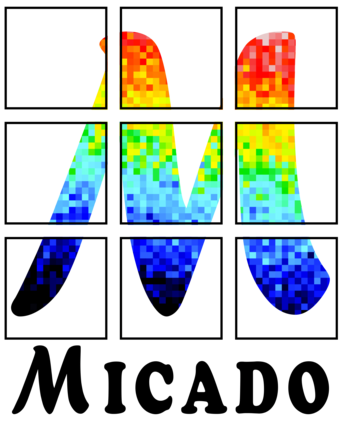MICADO
Multi-AO Imaging Camera for Deep Observations

MICADO is the Multi-AO Imaging Camera for Deep Observations. It will equip the 40-m-class Extremely Large Telescope with a first light capability for diffraction-limited imaging and long-slit spectroscopy at near-infrared wavelengths. It is being designed and built under the leadership of MPE by a consortium of partners in Germany, France, the Netherlands, Austria, Italy, and Finland together with ESO.
The instrument will work with a multiconjugate laser guide star adaptive-optics system (MCAO, developed by the MAORY consortium) as well as a single-conjugate natural guide star adaptive-optics system (SCAO, developed by the MICADO and MAORY consortia). If required for an initial phase, MICADO will be able to operate with just the SCAO system in a "stand-alone" mode.
With a point source sensitivity comparable to JWST and a resolution that is improved by about factor six, MICADO has the potential to address a large number of science topics that span the key elements of modern astrophysics. The science drivers focus on several main themes: the dynamics of dense stellar systems, black holes in galaxies and the center of the Milky Way, the star formation history of galaxies through resolved stellar populations, the formation and evolution of galaxies in the early universe, planets and planet formation, and the solar system. To address these, MICADO's key capabilities of sensitivity and resolution are ideal, as they are in turn used by its observing modes of imaging (covering a field of view of 50 arcseconds at 0.8 to 2.4 µm), astrometry (50 microarcseconds precision for brighter sources), coronagraphy (using focal and pupil plane coronagraphs), and slit spectroscopy (covering 1.49 to 2.45 µm and 0.82 to 1.55 µm at R ~ 20,000).

Major Milestones
October 2015: Kickoff
November 2018: Preliminary design review
April 2021: Start of final design review process
End of 2027: Start of Preliminary Acceptance Europe (PAE) process
2028: ELT first light with MICADO and start of science operations
2030: Final acceptance
Consortium
|
Germany |
|
| MPE |
Max-Planck-Institut für extraterrestrische Physik (Max Planck Institute for Extraterrestrial Physics), Garching
Primary Roles: PI & project management, science, systems engineering (including optics, mechanics, and electronics), cryostat, cold optics, focal plane masks & wheel, de-rotator, operational concept, imaging/astrometry pipeline (post-FDR), AIT equipment, system integration |
| MPIA |
Max-Planck-Institut für Astronomie (Max Planck Institute for Astronomy), Heidelberg
Primary Roles: Instrument scientist, science, astrometry analysis & calibration/operation concept, relay optics for stand-alone mode including electronics, instrument calibration units including electronics |
| USM |
Universitäts-Sternwarte München (University Observatory Munich)
Primary Roles: Science, main selection mechanism, spectrograph, pupil imager, electronics, control software including Software system engineering, preparation & observing software |
| IAG |
Georg-August-Universität Göttingen Stiftung Öffentlichen Rechts (University of Göttingen Public Law Foundation) represented by Institut für Astrophysik (Institute for Astrophysics)
Primary Roles: Science, support structure, co-rotating platform, cable wrap, handling/maintenance equipment |
|
Netherlands |
|
| NOVA |
Nederlandse Onderzoekschool voor de Astronomie (Netherlands Research School for Astronomy) is a federation of several astronomical institutes.
Specific contributions to MICADO come from the University of Groningen, the University of Leiden, and the NOVA optical/infrared instrumentation group based at ASTRON in Dwingeloo Primary Roles: Project scientist, science, ADC, filters & wheels, pupil masks & wheel, imaging/astrometry pipeline (pre-FDR), pipeline management, calibration plan |
|
Italy |
|
| INAF |
Instituto Nazionale di Astrofisica (National Institute for Astrophysics) represented by the Observatory of Padova
Primary Roles: Science, PSF reconstruction |
|
France |
|
| CNRS/INSU |
The National Institute For Earth Science and Astronomy of the French National Centre for Scientific Research, represented by the LESIA Space and Astrophysics Instrumentation Research Laboratory at Paris Observatory, the GEPI Galaxies, Stars, Physics and Instrumentation Laboratory at Paris Observatory, the UTINAM Universe, Time-Frequency, Interfaces, Nanostructures, Atmosphere-Environment and Molecules Institute, the LCF Charles Fabry Laboratory at Institut d’Optique Graduate School, and the IP2I Institute of Physics of 2 Infinites
Primary Roles: Science, high contrast imaging mode, SCAO module with the SCAO bench, dichroic, WFS, RTC, calibration unit, and including SCAO electronics & control SW |
|
Austria |
|
| A* |
An Austrian partnership collectively represented by the University of Vienna. It comprises the University of Vienna, the University of Innsbruck, the University of Graz, the University of Linz and RICAM Linz (Austrian Academy of Sciences)
Contributions to MICADO come from Vienna, Innsbruck, and Linz. Primary Roles: Science, data simulator (SimCADO), spectroscopic pipeline, PSF reconstruction algorithms |
|
Finland |
|
| FINCA |
Suomen ESO-keskus (Finnish Center for Astronomy with ESO), Turku
Primary Roles: Science, contribution to PSF reconstruction |
|
Europe |
|
| ESO |
European Southern Observatory
Primary Roles: Detector procurement & characterisation, detector control electronics & software, focal plane mosaic |



